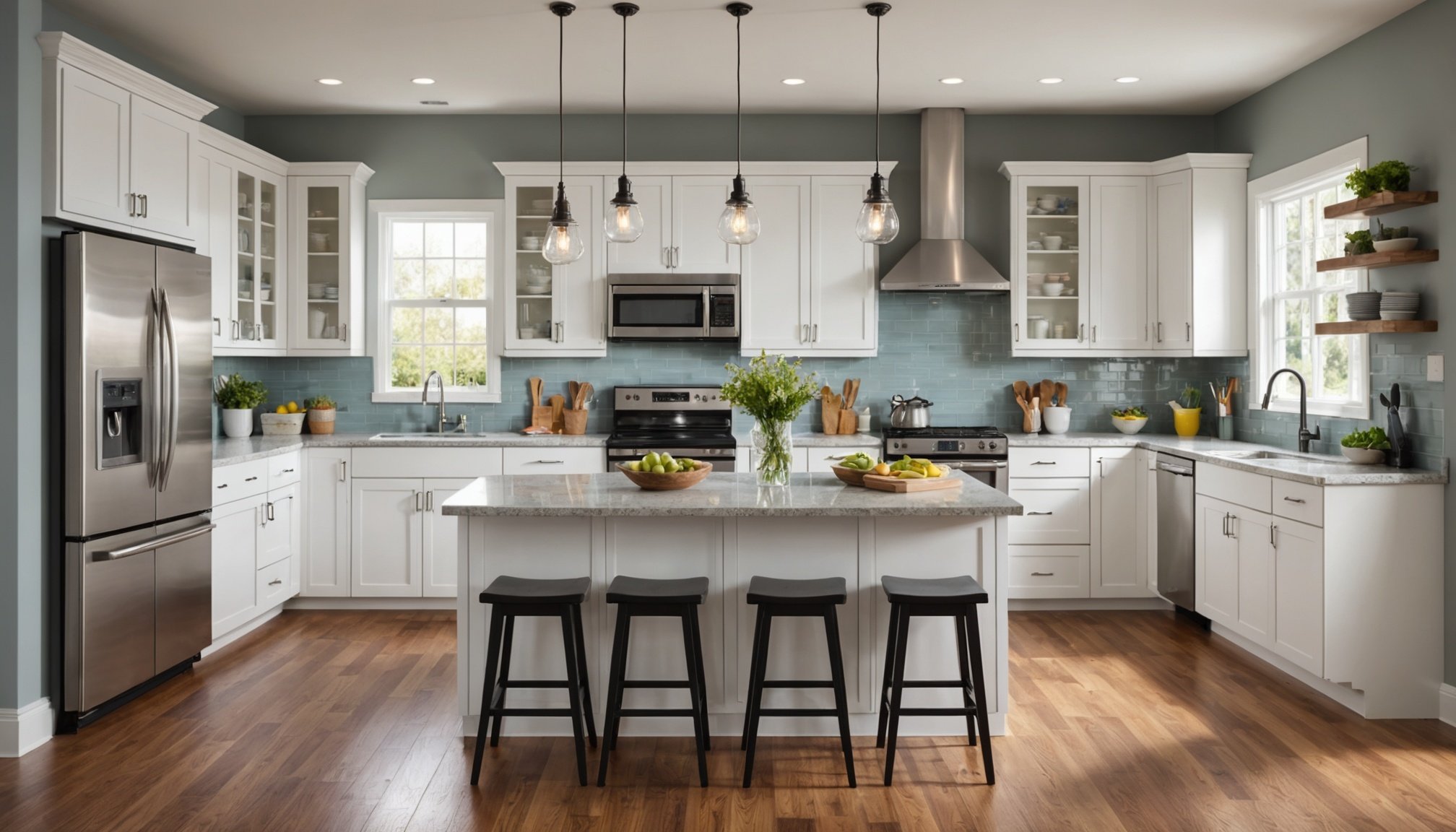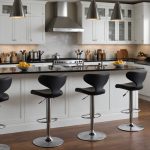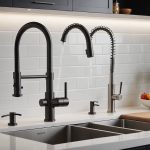Transform your kitchen into a haven for health and well-being by eliminating allergens. Innovative design tips can help you create a space that's not only aesthetically pleasing but also safe for those with sensitivities. From thoughtfully chosen materials to smart organization, each aspect plays a vital role in promoting a healthier lifestyle. Discover how simple changes can lead to a significant impact on your family's health and comfort. Embrace a kitchen free from allergens—your future self will thank you!
Understanding Allergens in the Kitchen
Exploring common allergens and their effects.
Also to discover : Designing a Low-Maintenance Kitchen: Tips for Effortless Cleaning and Care
Common Kitchen Allergens
The kitchen, often seen as the heart of the home, can also be a source of allergens. These irritants can stem from various sources, including food items like nuts, dairy, and gluten. Non-food sources such as cleaning agents and molds also contribute significantly. Recognizing these allergens is crucial for maintaining a safe environment.
Impact on Health and Well-being
Exposure to kitchen allergens can lead to a range of health issues, from mild discomfort to severe reactions. Symptoms may include respiratory problems, skin irritations, and digestive disturbances. For those with asthma or other respiratory conditions, these allergens can exacerbate symptoms, affecting overall well-being.
This might interest you : Designing Safer Kitchens for Seniors: Creative Solutions to Protect Our Elderly Loved Ones
Identifying Personal Allergens
Understanding personal sensitivities is vital. A proactive approach involves keeping a food diary and noting any reactions. Consulting with healthcare professionals for allergy testing can provide clarity.
Common Allergens in the Kitchen:
- Dairy products
- Nuts and seeds
- Wheat and gluten
- Shellfish
- Cleaning chemicals
By identifying and managing these allergens, individuals can create a safer, healthier kitchen environment. This empowers them to make informed decisions about their dietary choices and household products, fostering a positive impact on their health.
Kitchen Design Principles for Allergen Reduction
Creating a healthier space with thoughtful design.
Open vs. Closed Layouts
When considering an allergen-free kitchen design, the choice between open and closed layouts can significantly impact airflow. Open floor plans allow for better ventilation, which can help disperse allergens such as dust and cooking fumes. This setup can be particularly beneficial in reducing airborne irritants, making it a preferred choice for those with respiratory sensitivities.
Non-Porous Materials
Selecting non-porous materials for kitchen surfaces is a wise step towards minimizing allergens. Materials like stainless steel, quartz, and certain ceramics are less likely to harbor mold and bacteria. These surfaces are easier to clean, effectively reducing the risk of allergen buildup.
Easy-to-Clean Fixtures
Incorporating easy-to-clean fixtures and appliances is another key element of an allergen-free kitchen design. Look for appliances with smooth finishes and minimal crevices where allergens can accumulate. Regular cleaning becomes less cumbersome, promoting a healthier kitchen environment.
Key Considerations for Allergen-Free Design:
- Opt for open layouts for better airflow.
- Choose non-porous materials for countertops.
- Install easy-to-clean fixtures and appliances.
These design principles not only help in reducing allergens but also enhance the overall functionality and aesthetic appeal of the kitchen.
Innovative Storage Solutions for Allergen Management
Ensuring a safer kitchen environment through smart storage.
Designating Allergen-Free Zones
Creating allergen-free zones in your kitchen is essential for minimizing cross-contamination. Allocate specific shelves or drawers exclusively for allergen-free storage solutions. This clear separation helps in organizing food items and prevents accidental exposure to allergens.
Utilizing Airtight Containers
Airtight containers are practical tools in managing allergens. By storing food in these containers, you can limit exposure to air, reducing the risk of contamination. Opt for containers with secure seals to ensure effectiveness. This approach is particularly beneficial for storing flour, nuts, and other potential allergens.
Benefits of Airtight Containers:
- Prevents contamination
- Maintains freshness
- Organizes efficiently
Implementing a System for Tracking Food Expiration
An organized kitchen not only promotes health but also reduces waste. Implement a system to track food expiration dates. Label containers with purchase and expiration dates to ensure timely consumption. This practice supports allergen-free storage solutions by reducing the chance of using expired or contaminated products.
Incorporating these allergen-free storage solutions can significantly enhance the safety and organization of your kitchen, making it a more pleasant space for everyone.
Selecting Allergen-Friendly Materials
Choosing materials wisely for a healthier kitchen environment.
Best Countertop Materials for Allergen Sensitivity
Selecting allergen-friendly materials for countertops is crucial in minimizing allergen exposure. Quartz and stainless steel are excellent choices due to their non-porous nature, which prevents bacteria and mold accumulation. These materials are easy to clean, reducing the risk of allergen buildup.
Flooring Options That Minimize Allergen Accumulation
Flooring plays a significant role in an allergen-sensitive kitchen. Opt for materials like ceramic tiles or hardwood, which do not trap dust and are easy to maintain. Avoid carpets and rugs, as they tend to harbor allergens. Regular cleaning of these surfaces further enhances their effectiveness in maintaining a healthy kitchen.
Cabinet Materials That Resist Moisture and Bacteria
Cabinetry made from allergen-friendly materials can significantly impact kitchen hygiene. Choose cabinets with finishes that resist moisture, such as laminate or thermofoil. These finishes help prevent mold growth and bacterial accumulation.
Key Allergen-Friendly Materials:
- Quartz for countertops
- Ceramic tiles for flooring
- Laminate for cabinets
Incorporating these allergen-friendly materials ensures a safer kitchen environment, effectively reducing potential health risks associated with allergens.
Effective Cleaning Practices for Allergen Control
Implementing strategic cleaning can significantly reduce allergens.
Recommended Cleaning Products
Choosing the right cleaning products is essential for minimizing allergens in the kitchen. Opt for products labeled as non-toxic and hypoallergenic. These options are less likely to introduce additional irritants. Consider using natural alternatives like vinegar and baking soda, which are effective yet gentle on surfaces.
Establishing a Regular Cleaning Schedule
A consistent cleaning schedule is crucial in keeping allergens at bay. Aim to clean frequently touched surfaces, such as countertops and handles, daily. Weekly tasks should include mopping floors and wiping down cabinets. A monthly deep clean can address areas often overlooked, such as behind appliances.
- Daily: Countertops, handles
- Weekly: Floors, cabinets
- Monthly: Behind appliances
Techniques for Deep Cleaning
Deep cleaning helps eliminate hidden allergens. Start by removing everything from shelves and cabinets. Use a vacuum with a HEPA filter to capture fine particles. Follow with a damp cloth to wipe surfaces. For stubborn grime, a mixture of baking soda and water can be effective. Ensure thorough ventilation during this process to disperse any airborne particles.
Implementing these kitchen cleaning practices can create a safer environment, significantly reducing the presence of allergens.
Incorporating Air Quality Solutions
Enhancing kitchen air quality through strategic measures.
Importance of Ventilation in Reducing Allergens
Proper ventilation is crucial for maintaining optimal kitchen air quality. It helps disperse allergens such as cooking fumes and dust. Installing range hoods or exhaust fans can effectively remove airborne irritants, ensuring a healthier environment. Regularly cleaning these systems enhances their efficiency, reducing the buildup of allergens.
Selecting Air Purifiers for Kitchen Spaces
Choosing the right air purifiers can significantly improve kitchen air quality. Look for models with HEPA filters, which are designed to capture fine particles, including dust and pollen. Consider the size of your kitchen when selecting a purifier to ensure adequate coverage. Air purifiers with activated carbon filters can also help eliminate odors, further enhancing the kitchen atmosphere.
Recommended Features for Air Purifiers:
- HEPA filters for particle capture
- Activated carbon filters for odor removal
- Size-appropriate for kitchen space
Natural Methods for Maintaining Indoor Air Quality
Incorporating natural methods can complement mechanical solutions in maintaining indoor air quality. Houseplants, such as spider plants and peace lilies, can absorb toxins and release oxygen. Regularly opening windows allows fresh air to circulate, reducing the concentration of indoor allergens. These simple steps contribute to a healthier kitchen environment.
Visual Examples and Case Studies
Showcasing successful transformations for inspiration.
Allergen-Free Kitchen Designs
Creating an allergen-free kitchen is not just about safety; it's also about style and functionality. Many homeowners have successfully transformed their kitchens into spaces that are both beautiful and free from common allergens. For instance, one family replaced their porous countertops with quartz, enhancing both hygiene and aesthetics. Another homeowner opted for a sleek, open layout, improving airflow and reducing allergen accumulation.
Before and After Transformations
The journey from a traditional kitchen to an allergen-free haven can be remarkable. Consider a case where outdated cabinets were replaced with laminate finishes that resist moisture and bacteria. The transformation not only improved the kitchen's appearance but also its functionality.
Before and After Highlights:
- Old wooden cabinets ➔ Moisture-resistant laminate
- Carpeted flooring ➔ Ceramic tiles
- Cluttered spaces ➔ Open and airy layouts
Testimonials from Homeowners
Homeowners who have embraced allergen-free designs often express relief and satisfaction. One testimonial reads: "Our family's health has improved significantly since we made our kitchen allergen-free. The changes were simple yet impactful." Another homeowner noted the ease of maintenance with non-porous surfaces, stating, "Cleaning is now a breeze, and we feel safer."
These examples illustrate the practical and aesthetic benefits of adopting an allergen-free kitchen design.
Resources and Product Recommendations
Discover essential tools and materials for an allergen-free kitchen.
Reputable Suppliers for Allergen-Friendly Materials
Creating an allergen-free kitchen begins with sourcing the right materials. Look for suppliers specializing in non-porous surfaces like quartz and stainless steel. These materials are essential for minimizing allergen accumulation. Suppliers often offer a variety of options tailored to different kitchen designs, ensuring both functionality and aesthetic appeal.
Recommended Cleaning Tools and Products
Maintaining an allergen-free kitchen requires effective cleaning tools. Consider using microfiber cloths, which trap dust and allergens effectively. For cleaning products, opt for non-toxic, hypoallergenic solutions. These products are designed to clean thoroughly without introducing additional irritants.
Essential Cleaning Tools:
- Microfiber cloths for dust trapping
- Non-toxic cleaners for safe use
- HEPA filter vacuums for fine particles
Expert Advice and Guides for Further Reading
For those seeking to deepen their understanding of allergen-free kitchen practices, expert guides are invaluable. These resources provide detailed insights into selecting materials and maintaining a clean environment. Consulting with professionals can also offer personalized advice tailored to specific needs, ensuring a comprehensive approach to kitchen design and maintenance.
By utilizing these resources and products, individuals can effectively manage allergens and create a healthier kitchen space.












